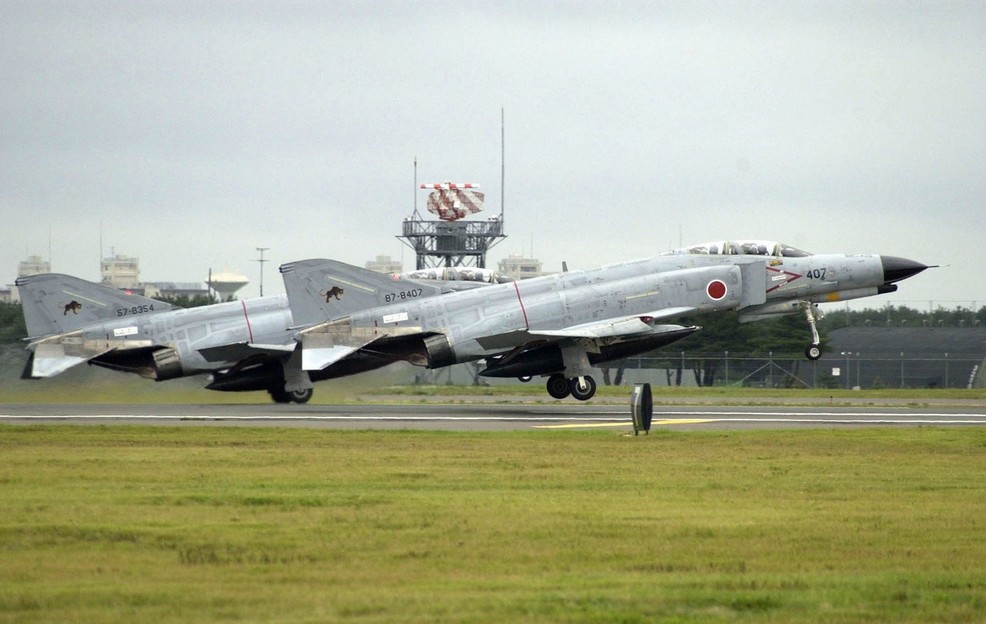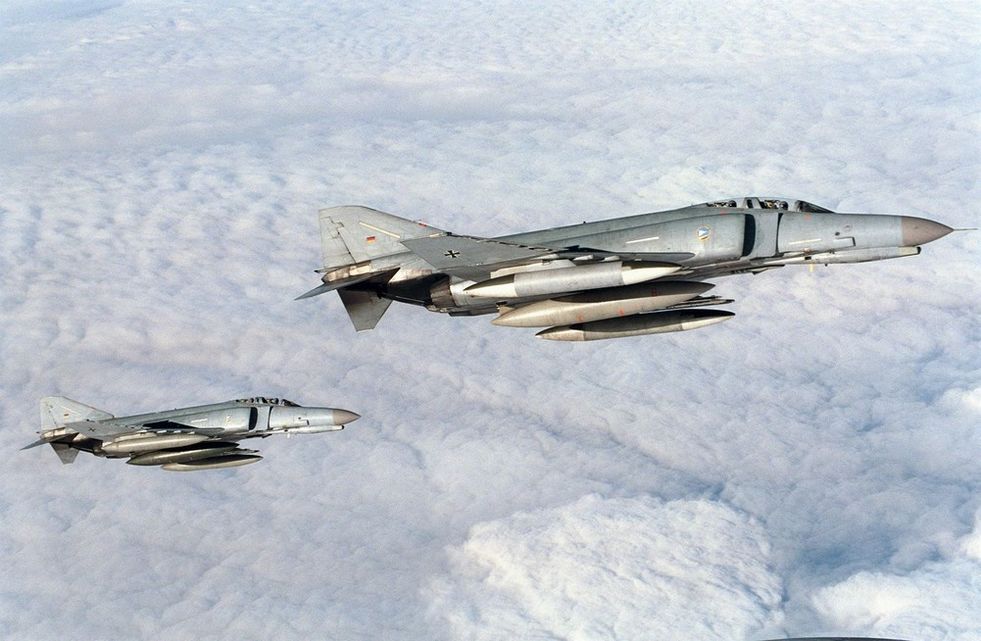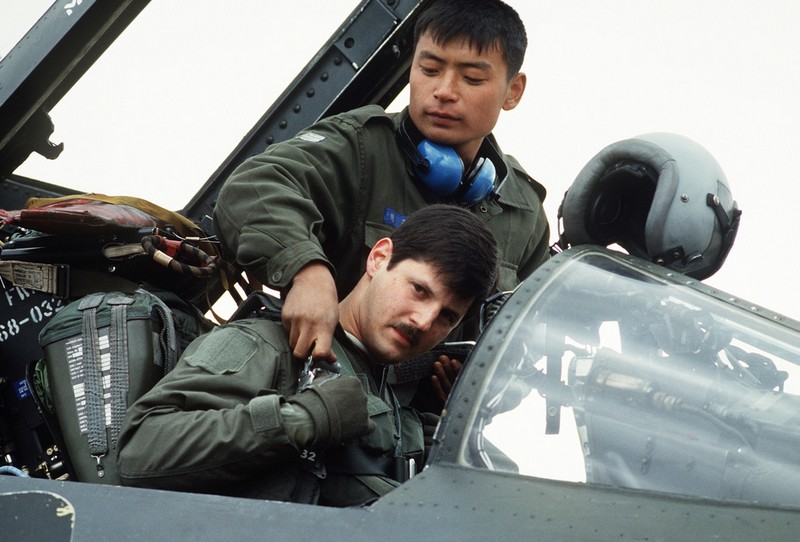Foreign Service: The Legacy of a Phantom
The F-4's legacy did not stop at the US border. Its performance made it of interest to many US allies of its era, and the Phantom II remains in limited service as of this writing. With the F-4E being the most numerous of the type, it was natural that it would be the model with the furthest reach.
Amidst the ever-evolving landscape of military technology, foreign operators of the F-4E undertook comprehensive upgrades and modernization efforts. These initiatives were aimed at extending the aircraft's service life and enhancing its combat capabilities. The F-4E, with its powerful engines, evolved to meet the demands of contemporary warfare, solidifying its place as a venerable platform in the arsenals of its adoptive nations.
The F-4E Phantom II's foreign service was not merely a chapter in the history of military aviation, but a saga that unfolded across continents and through the corridors of geopolitical power. Its adaptability, longevity, and combat prowess etched the Phantom into the collective memory of the nations that flew it, leaving an enduring legacy in the skies it once dominated.
 Hellenic Air Force RF-4E Phantom II lands at RIAT 2008, UK
Hellenic Air Force RF-4E Phantom II lands at RIAT 2008, UK
Israel
The first nation to receive the F-4E on export, Israel, designated it Kurnass (Sledgehammer).
Phantom would see combat with the IAF within months of delivery, seeing multiple kills in the war of attrition against Egypt and skirmishes with Syria. The 1973 Yom Kippur War would see the Phantom acquit itself spectacularly, downing 85 Arab aircraft in exchange for 5 lost in air combat. But it was the Phantom's performance as an air-to-ground asset that would draw the most focus from the IAF, seeing the F-4E specializing in that role, as the F-15 and F-16 were made available to the nation for export purchase.
The Kurnass would ultimately receive a number of vital upgrades to keep the type viable beginning in 1987, with the installation of the APG-76 radar, a new mission computer and HUD, and the ability to deliver the Popeye air-to-surface missile. The IAF would ultimately receive between 212 and 222 F-4Es.
Australia
Australia would be the second import customer for the F-4E, but only on a limited time basis. Twenty-four F-4Es were provided to the RAAF on a lease basis by the United States as a stopgap measure due to delays in deliveries of the F-111C.
The F-4E would operate in Australian service for just three years, from September 1970 to 1973. Australian aircrews were impressed with the Phantom's performance for their needs, and while the US offered to let the RAAF buy the leased airframes outright, this offer was ultimately rejected.
Japan
 F-4EJ Kais of the JASDF of
the 8th Hikōtai taking off in 2002, US Navy Photo
F-4EJ Kais of the JASDF of
the 8th Hikōtai taking off in 2002, US Navy Photo
With permission from the US State Department and license terms with McDonnell Douglas, Mitsubishi Heavy Industries would build the F-4E locally, designated as the F-4EJ. The -4EJ would be provided compatibility with Japanese-built weapons, but the omission of the refuelling probe and AJB-7 bombing computer due to treaty restrictions on the JASDF.
The -4EJ was updated as the 'Kai' in 1984, receiving the APG-66J radar and ASM-1 and - 2 anti-shipping missiles. The F-4EJ would serve Japan for over 40 years, with the final examples being withdrawn in March of 2021.
Iran
First receiving the F-4E in 1971, the IIAF received 177 F-4Es through various delivered batches into the late 1970s. In the aftermath of the Iranian Revolution, now-IRIAF F-4Es saw extensive use - and numerous successes, against the forces of Saddam Hussein.
The first raid on the Osirak Nuclear Plant in September 1980 was performed by four F-4Es, damaging the reactor and control facilities; this raid preempted the more famous IAF attack on the same facility that destroyed it permanently. In similar fashion, April 1981 saw F-4Es as the primary strike aircraft during the raid on all three airfields of the H-3 complex in western Iraq.
The conflict with Iraq came at a substantial cost to both airframes and crews, with Western weapons embargoes severely limiting the ability of the IRIAF to maintain the Phantom II effectively. By the end of the war, even local estimates put the available number of flyable F-4s below four dozen. While local industry attempted to revitalize the Phantom in the aftermath of the conflict, current evaluations put their total F-4 force near 60, between their remaining F-4D, F-4E, and RF-4Es.
Greece
The Hellenic Air Force's initial F-4E deliveries began in 1974, with annual deliveries stopped due to politics in 1981. The HAF's combined Phantom II force topped out at 121 airframes purchased (F-4E and RF-4E), with reinforcement stocks of former USAF jets, bringing that number to its final value in the post-Desert Storm drawdown.
Upgrades by DASA to Greek Phantoms have been extensive and were built around a similar model to the Luftwaffe's F-4F ICE. Most notably, the HAF F-4E has received the APG-65 for AMRAAM (including a replacement digital BUS), HUD, and LITENING pod compatibility.
The HAF Phantoms have also received specific upgrades based on their intended squadron roles, with inertial navigation replacement and GPS inclusion for those specializing in the air-to-surface role. Greece currently retains over 30 Phantoms on active duty.
Turkey
Turkey's Phantom service has been extensive, with over 160 F-4Es procured (along with an additional 60+ RF-4Es), beginning in 1974. Deliveries of Phantoms have been both new build and former USAF, and in the mid-90s, Israeli Aerospace Industries (IAI) was tapped to bring them into the next century.
Based around a proposed upgrade program for the IAF, the F-4E Terminator 2020 deleted over 1600 lbs of excess weight from the aircraft by wiring and hydraulic system replacements, integrated the Elta M-2032 radar, a full HOTAS implementation, MFDs, a true HUD, and extensive weapons systems updates, Popeye and GBU integration, as well as the LITENING II targeting pod. The Turkish Air Force intends to maintain the remaining 30 or so airframes in service until the mid-2030s.
Germany
 F-4Fs of the German
Air Force in 1998, USAF Photo
F-4Fs of the German
Air Force in 1998, USAF Photo
Primarily an F-4F and RF-4E customer - the largest F-4 export recipient with 263 delivered overseas, Germany would purchase 10 F-4Es to be based in the United States for the type conversion of their aircrews training alongside USAF units.
South Korea
 A Korean Air Force crew chief helps a 497th Tactical Fighter Squadron pilot
into the cockpit of his F-4E during Exercise TEAM SPIRIT 1986
A Korean Air Force crew chief helps a 497th Tactical Fighter Squadron pilot
into the cockpit of his F-4E during Exercise TEAM SPIRIT 1986
A long-time F-4 recipient, South Korea supplanted its force of F-4Ds with brand new F-4Es beginning in 1977, ultimately purchasing a total of 103.
South Korea was the recipient of the final US-built F-4 Phantom, 78-0744, in October 1979. As of this writing, the RoKAF retains the F-4E in service, with the intention of withdrawing it in 2024.
Egypt
The final F-4E export customer, Egypt, received purchasing rights through its peace treaty with Israel and the Peace Pharaoh agreement; rather than newly build airframes, Egypt received 35 former USAF aircraft.
The Phantom was ultimately a precursor towards the nation's purchase of the F-16, and went through initial difficulties in servicing by their maintenance crews. McDonnell Douglas advisors aided the Egyptian squadrons in getting their operational ready rates back up to standard, and the Phantom II went on to serve the EAF into the late 90s.